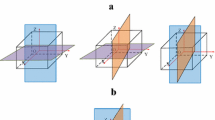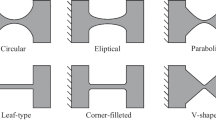Abstract
In design of flexure mechanism, diminishing the parasitic-motion is a key point to improve the accuracy. However, most of existing topics concentrate on improving the accuracy of linear-motion flexure mechanisms via compensating the parasitic error, but few research the multi-dimensional flexure mechanisms. A general design principle and method for high-precision flexure mechanisms based on the parasitic-motion compensation is presented, and the proposed method can compensate the parasitic rotation in company with translation, or the parasitic translation in company with rotation, or both. The crucial step for the method is that the parasitic motion of a flexure mechanism is formulated and evaluated in terms of its compliance. The overall compliance matrix of a general flexure mechanism is formulated by using screw theory firstly, then the criteria for the parasitic motions is introduced by analyzing the characteristics of the resultant compliance matrix as well as with aid of the concept of instantaneous rotation center. Subsequently, a compliance-based compensation approach for reducing parasitic-motion is addressed as the most important part. The design principles and procedure are further discussed to help with improving the accuracy of flexure mechanisms, and case studies are provided to illustrate this method. Finally, an analytical verification is provided to demonstrate that the symmetry design philosophy widely used in flexure design can effectively improve accuracy in terms of the proposed method. The proposed compensation method can be well used to diminish the parasitic-motion of multi-dimensional flexure mechanisms.
Similar content being viewed by others
References
SMITH S T. Flexures: elements of elastic mechanisms[M]. New York: Gordon and Breach Science Publishers, 2000.
HOWELL L L. Compliant mechanisms[M]. New York: Wiley-interscience Publication, 2001.
CULPEPPER M L, ANDERSON G, PETRI P. Design of a low-cost nano-manipulator which utilized a monolithic, spatial compliant mechanism[J]. Precision Engineering, 2004, 28(4): 469–482.
LOBONTIU N. Compliant mechanisms: design of flexure hinges[M]. Florida: CRC Press, 2002.
PATIL C B, SREENIVASAN S V, LONGORIA R G. Analytical and experimental characterization of parasitic motion in flexure-based selectively compliant precision mechanisms[C]// Proceedings of the ASME IDETC/CIE 2008, Brooklyn, New York, USA, August 3–6, 2008: 393–404.
AWTAR S, SLOCUM A H, SEVINCER E. Characteristics of beam-based flexure modules[J]. Journal of Mechanical Design, 2007, 129(6): 625–639.
TREASE B P, MOON Y M, KOTA S. Design of large-displacement compliant joints[J]. Journal of Mechanical Design, 2005, 127(4): 788–798.
SPANOUDAKIS P, SCHWAB P, JOHNSON P. Design and production of the METOP satellite IASI corner cube mechanisms[C]//Proceedings of the 10th European Space Mechanisms and Tribology Symposium, San Sebastian, Spain, September 24–26, 2003: 97–103.
HENEIN S, KJELBERG I, ZELENIKA S. Flexible bearings for high-precision mechanisms in accelerator facilities[C]//Proceedings of the 26th Advanced ICFA Beam Dynamics Workshop on Nanometre-Size Colliding Beams, Lausanne, Switzerland, September 2–6, 2002: 103–110.
CANNON B R, LILLIAN T D, MAGLEBY S P, et al. A compliant end-effector for microscribing[J]. Precision Engineering, 2005, 29(1): 86–94.
DUARTE R, HOWELLS M R, HUSSAIN Z, et al. A linear motion machine for soft x-ray interferometry[C]//Proceedings of the SPIE 1997 Conference, San Diego, CA, July 31–August 1, 1997: 224–232.
CHOI K B, LEE J J, KIM M Y. Cartwheel flexure-based compliant stage for large displacement driven by a stack-type piezoelectric element[C]//Proceedings of the International Conference on Control, Automation and Systems 2007, COEX, Seoul Korea, October 17–20, 2007: 2754–2758.
ZHAO Hongzhe, BI Shusheng, YU Jingjun. A novel compliant linear-motion mechanism based on parasitic motion compensation[J]. Mechanism and Machine Theory, 2012, 50: 15–28.
HUBBARD N B, WITTWER JW, KENNEDY J A, et al. A novel fully compliant planar linear-motion mechanism[C]//Proceedings of the ASME IDETC/CIE 2004, Salt Lake City, Utah, USA, September 28–October 2, 2004: 1–5.
ROMAN G A, WIENS G J. MEMS optical force sensor enhancement via compliant mechanism[C]//Proceedings of the ASME IDETC/CIE 2007, Las Vegas, USA, September 4–7, 2007: 127–135.
CHANG S H, LI S S. A high resolution long travel friction drive micropositioner with programmable step size[J]. The Review of Scientific Instruments, 1999, 70(6): 2776–2782.
WANG Y C, CHANG S H. Design and performance of a piezoelectric actuated precise rotary positioned[J]. The Review of Scientific Instruments, 2006, 77(10): 313–317.
AWTAR S, SEN S. A generalized constraint model for two-dimensional beam flexures: Nonlinear load-displacement formulation[J]. Journal of Mechanical Design, 2010, 132(8):081008.1–081008.11.
AWTAR S, SEN S. A generalized constraint model for two-dimensional beam flexures: Nonlinear strain energy formulation[J]. Journal of Mechanical Design, 2010, 132(8):081009.1–081009.11.
BALL R S. A Treatise on the theory of screws[M]. Cambridge: Cambridge University Press, 1900.
SU Haijun, YU Jingjun. Analytical compliance analysis and synthesis of flexure mechanisms[C]//Proceedings of the ASME IDETC/CIE, Washington, DC, August 28–31, 2011: 169–180.
HOPKINS J B, CULPEPPER M L. A screw theory basis for quantitative and graphical design tools that define layout of actuations to minimize parasitic errors in parallel flexure systems[J]. Precision Engineering, 2010, 34(4): 767–776.
LI Shouzhong, YU Jingjun, ZONG Guanghua, et al. A compliance-based compensation approach for designing high-precision flexure mechanism[C]//Proceedings of the ASME IDETC/CIE 2012, Chicago, Illinois, USA, August 12–15, 2012: 293–301.
VON M. Motorrechnung: ein neues hilfsmittel in der mechanic[J]. zeitschrift fur angewandte mathematic und mechanic, 1924, 4(2): 155–181.
YU Jingjun, LI Shouzhong, SU Haijun, et al. Screw theory based methodology for the deterministic type synthesis of flexure mechanisms[J]. Journal of Mechanisms and Robotics, 2011, 3(3):031008.1–031008.14.
Author information
Authors and Affiliations
Corresponding author
Additional information
Supported by National Natural Science Foundation of China(Grant No. 51305022), the Fundamental Research Funds for the Central Universities, China(Grant No. FRF-TP-13-013A), and National Science Foundation for Post-doctoral Scientists of China(Grant No. 2012M520163)
LI Shouzhong, born in 1983, is currently a Post-PhD at School of Mechanical Engineering, University of Science and Technology Beijing, China. He received his PhD degree from Beihang University, China, in 2012. His research interests include flexure mechanisms.
YU Jingjun, born in 1974, is currently an associate professor at Robotics Institute, Beihang University, China. His research interests include compliant mechanisms, parallel mechanisms, and robotic geometry.
Rights and permissions
About this article
Cite this article
Li, S., Yu, J. Design principle of high-precision flexure mechanisms based on parasitic-motion compensation. Chin. J. Mech. Eng. 27, 663–672 (2014). https://doi.org/10.3901/CJME.2014.0415.076
Received:
Revised:
Accepted:
Published:
Issue Date:
DOI: https://doi.org/10.3901/CJME.2014.0415.076




